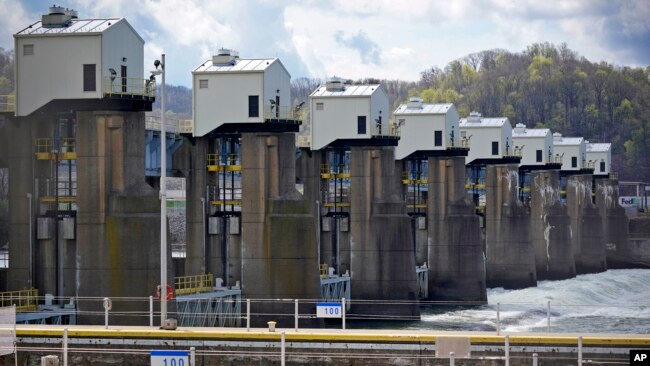アメリカにおける水力発電産業
オバマ政権時代、再生エネルギーを不安政策の中で、水力発電に大きく舵を切り、2050年までに1.5倍にする政策を推進しています。日本には豊かな水資源があるのに水力開発が進まないのは、水力価値への認知度の低さ、また、国の水力開発に対する戦略や推進体制が整っていないことだと、京都大学 角哲也教授は指摘します。
※文献:水力開発で期待される国内外の価値想像(京都大学 防災研究所 水源環境研究センター 角 哲也教授に聞く)より
今回のウクライナの事案でも明瞭であるように、電力確保な国家安全保障上重要なことです。山岳地帯であり、海に囲まれた地形からエコエネルギーは利用不可欠なものではないでしょうか。強いリーダーシップ不在の日本丸はすべてに置いてどこへ向かうのでしょうか?
VOAで英語を学び、環境と水力電源について学びましょう!!
米国で成長余地のある水力発電産業(和訳)
Hydropower Industry Sees Room for Growth in US
March 27, 2022
低炭素エネルギーの利用を推進する米国では、最近、水力発電業界と一部の環境保護団体との関係が改善されつつあります。
最近の妥協点は、ジョー・バイデン大統領のインフラ整備法に見られるもので、水力発電やエネルギー貯蔵のためのダム撤去や既存の構造物の改良を含むプロジェクトに25億ドルを投入するものです。
環境保護を理由にダム撤去を推進してきた団体American Riversのテッド・イルストン氏は、最近AP通信に対し、「これ(水力発電)は、おそらく移行期に何らかの役割を果たすことになるでしょう。石炭よりいいのは確かです」と認識していることを明かしました。
米国における水力発電
水力発電は、水の流れを利用して発電機に接続されたタービンを動かすものです。米国で最も古く、風力発電に次いで2番目に大きな再生可能エネルギーの一種です。2020年には、全米の発電量の約7パーセントを占めています。
風力発電や太陽光発電ほど連邦政府の資金援助を受けていませんが、成長の余地があると考えられています。全米にある9万基のダムのうち、電力を生み出しているのは約2,500基。電力供給協会が2012年の連邦政府のデータに基づいて行った試算によると、未発電ダムで900万から1200万世帯分の電力を生み出すことができるそうです。
※Non-powered dams:平野を緩やかに流れている河川にあるダムで、これまで電力利用されていなったが、オバマ政権時代電力ダムにする政策により電力を生み出すようになった。
引用元:「水力現場の新たな価値想像」(京都大学 角哲也教授著)
ペンシルバニア州南西部では、ボストンに本社を置く水力発電会社ライ・デベロップメント社が、8つのダムにタービンを追加して発電しています。同社は、構造物を改良することで、河川の水質や魚類への被害を抑えることができると言います。
ライ社は、既存のダムで水力発電を拡大する一方で、環境への影響を最小限に抑えることに取り組んでいる企業のひとつです。
米国では、ほとんどのダムが50年以上前に建設されたものであることが困難の一因です。
ダム崩壊の危険性から、近年はダムの撤去や取り壊しが増加しており、過去100年間に米国で行われたダム撤去の40%以上がこの10年間に行われたものです。
先月、連邦政府当局は、米国史上最大のダム撤去の承認に一歩近づきました。オレゴン州とカリフォルニア州の州境近くにあるクラマス川の4つの水力発電ダムを撤去すれば、構造物のために繁殖地に到達できない同川のサケやその他の魚類を保護することができます。
進行中の議論
最近、水力発電業界と環境保護団体の関係は改善されつつあるが、まだ意見の相違はある。メイン州のケネベック川では、環境保護団体と州の環境当局が、絶滅の危機に瀕したアトランティックサーモンが重要な地域に到達するのを阻む4つの水力発電ダムの撤去を推進しています。このダムは州の再生可能エネルギーの約5パーセントを作り出しています。
低環境負荷水力発電研究所のシャノン・エイムズ氏は次のように述べています。
「個々の河川システムが、気候変動や再生可能エネルギーの必要性のメッセージに紛れてしまうのは、とても簡単なことです。」
干ばつがアメリカ西部の水力発電に影響を与える中、この業界は東部の州でより直接的な成長への道を歩んでいます。
ペンシルバニア州では、ライ社は低環境負荷水力発電研究所と早い段階で出会い、同協会からの認証を求める少数の企業の中に入っています。
認定を受けるには、その構造物が絶滅危惧種の保護に適合していることを証明しなければなりません。同団体の環境要件は、州や連邦政府の規則よりも厳しいことが多いそうです。
Hydropower Industry Sees Room for Growth in US
As the United States pushes to use more low-carbon energy, there has been a recent improvement in relations between the hydropower industry and some environmental groups.
The recent compromises are found in President Joe Biden’s infrastructure law, which puts $2.5 billion toward projects including dam removals as well as improvements to existing structures for hydropower and energy storage.
Ted Illston of American Rivers, a group that has pushed for dam removals on environmental grounds, recently told the Associated Press that the group recognizes “that (hydropower) is probably going to play some role in the transition. It’s certainly better than coal.”
Hydropower in the United States
Hydropower uses flowing water to move turbines connected to generators. It is the oldest and second-largest sort of renewable energy in the U.S. after wind power. In 2020, it accounted for roughly 7 percent of the electricity generated in the country.
The industry has not received as much federal money as wind and solar, but sees room for growth. Of the 90,000 dams in the country, about 2,500 produce power. Non-powered dams could produce enough power for 9 to 12 million homes, said an estimate by the Electric Power Supply Association based on federal data from 2012.
In southwestern Pennsylvania, Rye Development, a Boston-based hydropower company, is adding turbines to eight dams to generate electricity. The company says the improved structures will limit damage to the rivers’ water quality and fish.
Rye is among the companies that sees an opportunity to expand hydropower production at existing dams while working to minimize environmental harms.
Part of the difficulty is that most dams in the U.S. were built more than fifty years ago.
The risk of dam collapses has led to increased dam removals or demolitions in recent years, with more than 40 percent of the country’s dam removals in the past century happening in the last ten years.
Last month, federal officials moved a step closer to approving what would be the largest dam demolition in U.S. history. Removal of the four hydroelectric dams on the Klamath River near the Oregon-California border would help save the river’s salmon and other fish species that cannot reach breeding areas because of the structures.
Ongoing debates
Despite some recent improvements in relations between the hydropower industry and environmental groups, there are still disagreements. On Maine’s Kennebec River, environmental groups and state environmental agencies are pushing for the removal of four hydropower dams that block endangered Atlantic salmon from reaching key areas. The dams make about 5 percent of the state’s renewable energy.
Shannon Ames of the Low Impact Hydropower Institute said,
“It’s very easy for individual river systems to get lost in the message of climate change and the need for renewable energy.”
With drought affecting hydropower production in America’s West, the industry has a more direct path to growth in eastern states.
In Pennsylvania, Rye met with the Low Impact Hydropower Institute early in its process and is among a small number of companies seeking certification from the group.
To get certified, companies must show their structures meet protections for endangered species. The group says its environmental requirements are often stricter than state or federal rules.
Words in This Story
infrastructure – n. the basic equipment and structures (such as roads and bridges) that are needed for a country, region, or organization to function properly
transition – n. a change from one state or condition to another
turbine – n. an engine that has a part with blades that are caused to spin by pressure from water, steam, or air
species – n. biology : a group of animals or plants that are similar and can produce young animals or plants : a group of related animals or plants that is smaller than a genus
drought – n. a long period of time during which there is very little or no rain
certification – n. official approval to do something professionally or legally
